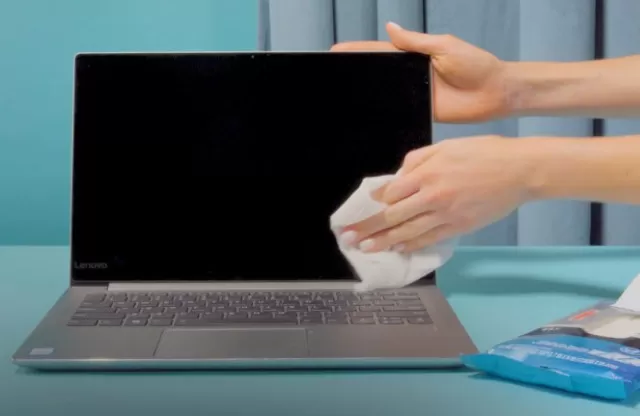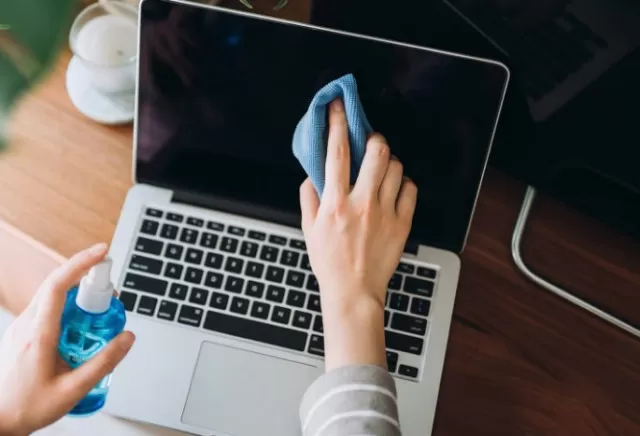2 Ways Cleaning Your Computer Monitor. Is your computer monitor looking blurry or covered in dust, fingerprints, smudges, or splatters from food and drinks?
It’s time to clean it up! However, it’s important to note that not all Computer Monitors are created equal and they can’t all be cleaned the same way.
Before attempting to clean your monitor, be sure to read the user manual or visit the manufacturer’s website for cleaning instructions. Glass-coated screens, like those on newer iMacs and Macbooks, are less delicate than non-glass-coated screens, found on most Windows computers, many touchscreens, and matte displays. If you’re unsure of the type of screen you have, use the least aggressive cleaning methods to remove dust and grime to avoid damaging it and potentially having to buy a new monitor.
How Often Should You Clean Your Computer Monitor??
The frequency at which you should clean your computer monitor depends on several factors, such as the environment and your usage habits.
If the area is prone to dust or you touch the screen often, or if you are not careful while eating or drinking around the monitor, you may need to clean it more frequently. However, for most users, a weekly cleaning routine is sufficient to keep the monitor clean and functioning properly.
How to Safely Clean a Glass-Coated Computer Monitor

Turn off the power: Make sure your computer monitor or laptop is turned off and has cooled down before cleaning it to avoid electrical shock.
Dust with a microfiber cloth: Use a clean microfiber cloth or an eyeglass towel to wipe away dust from the screen.
Fold the cloth in quarters, start at the top of the monitor and wipe side to side. Move to a clean side of the cloth and wipe from the top to the bottom to capture all of the dust.
Apply gentle pressure to remove most of the finger smudges.
Remove stubborn smudges: If there are stubborn smudges or bits of stuck-on food on the screen, dampen a clean microfiber cloth with distilled water or isopropyl alcohol.
Make sure the cloth is only slightly damp, not dripping. Use the cloth to wipe away any remaining gunk.
Dry the monitor screen: Use a clean section of the dry microfiber cloth to dry the monitor screen.
Disinfect housing: Use a disinfectant wipe to remove grime and dust from the outer housing of the monitor.
Do not use a disinfecting wipe on the actual screen. Allow the housing to dry completely and turn on the monitor.
Note: Glass-coated computer monitors can tolerate more cleaning solutions, but still be sure to follow the manufacturer’s instructions to avoid damage.
How to Safely Clean Non-Glass-Coated Computer Monitors

Firstly, it’s important to note that cleaning a computer monitor should be done regularly to maintain its performance and longevity.
The frequency of cleaning depends on the environment and usage habits. For example, if you work in a dusty area or frequently touch the screen, you should clean it more often.
On the other hand, if you’re careful and don’t eat or drink around the monitor, weekly cleaning is usually enough.
When it comes to cleaning, the method varies depending on whether the monitor is glass-coated or non-glass-coated.
Glass-coated screens, such as those found on some iMacs and Macbooks, can be cleaned more aggressively, while non-glass-coated screens, such as LED or LCD screens, require a gentler touch.
For glass-coated screens, start by turning off the power and allowing the monitor to cool completely.
Then, use a microfiber cloth or eyeglass towel to wipe away dust from the screen. Fold the cloth in quarters and wipe side to side from the top of the monitor to the bottom, then switch to a clean side of the cloth and wipe from the top to the bottom again to capture all of the dust.
If there are stubborn smudges or bits of stuck-on food, dampen a clean microfiber cloth with distilled water or isopropyl alcohol and use it to wipe away any remaining gunk. Finally, use a dry section of the cloth to dry the monitor screen.

For non-glass-coated screens, the process is similar but requires a lighter touch.
Start by turning off the power and allowing the monitor to cool completely. Use a dry microfiber cloth to remove dust from the screen, starting from the top and moving towards the bottom.
If there are smudges that don’t come off while dusting, slightly dampen a clean microfiber cloth with water only and use gentle pressure to wipe only the smudged areas. Immediately use a clean, dry microfiber cloth to dry the screen.
In both cases, it’s important to never use harsh chemicals or abrasive cloths, as they can damage the screen.
And for both types of screens, use a disinfectant wipe to clean the screen housing and control areas, but never use disinfectant on the actual screen. Allow the housing to air-dry completely before turning the monitor back on.
Overall, cleaning your computer monitor doesn’t have to be complicated, but it does require a bit of care and attention.
By following these tips and cleaning your monitor regularly, you can keep it looking great and performing well for years to come.
*The information is for reference only.